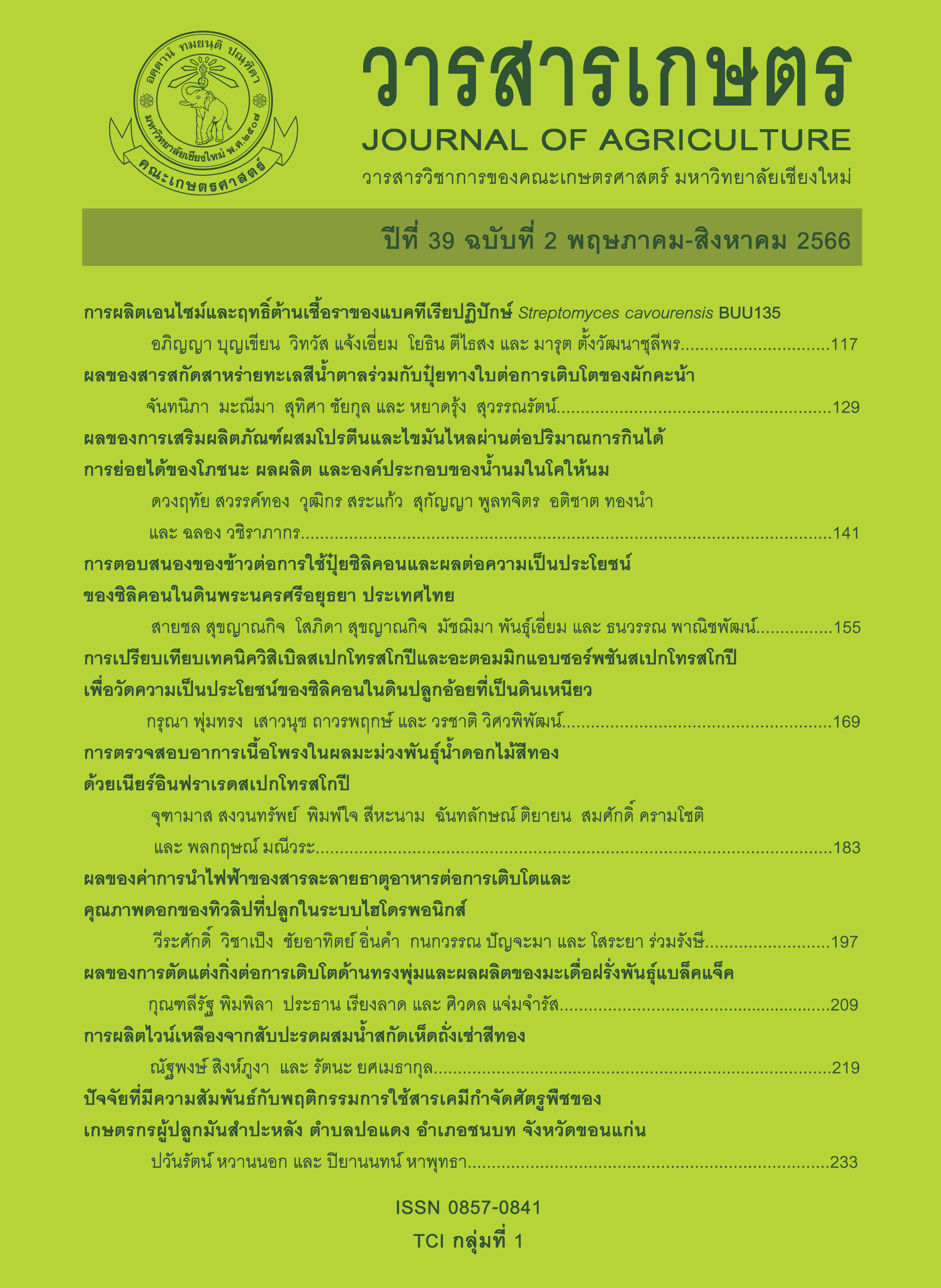ผลของการตัดแต่งกิ่งต่อการเติบโตด้านทรงพุ่มและผลผลิตของมะเดื่อฝรั่งพันธุ์แบล็คแจ็ค
Main Article Content
บทคัดย่อ
การศึกษาการตัดแต่งกิ่งมะเดื่อฝรั่งเพื่อให้ทราบถึงศักยภาพของการเจริญเติบโตทางกิ่งใบที่ส่งผลต่อการให้ผลผลิตและคุณภาพของผลผลิต และได้ทราบถึงสัดส่วนของพื้นที่ใบที่เหมาะสมกับผลผลิตมะเดื่อฝรั่งที่มีคุณภาพ โดยทำการทดลองกับมะเดื่อฝรั่งพันธุ์แบล็คแจ็คอายุ 1 ปี ที่ปลูกในตะกร้าพลาสติกขนาด 14 นิ้ว ในโรงเรือนแบบกึ่งปิด โดยทำการตัดแต่งกิ่งให้เหลือจำนวนกิ่งในการเจริญเติบโตและให้ผลผลิตในปริมาณที่แตกต่างกันหลังการเก็บเกี่ยวผลผลิต 1 ปีแรก วางแผนการทดลองแบบสุ่มในบล็อคสมบูรณ์ (RCBD) ประกอบด้วย 1) ไม่ตัดแต่งกิ่ง 2) ตัดแต่งกิ่งเหลือ 2 กิ่ง 3) ตัดแต่งกิ่งเหลือ 4 กิ่ง และ 4) ตัดแต่งกิ่งเหลือ 6 กิ่ง พบว่าการตัดแต่งกิ่งมะเดื่อฝรั่งไม่มีผลต่อความกว้างของทรงพุ่ม แต่การตัดแต่งกิ่งเหลือ 4 กิ่ง มีผลทำให้ต้นมะเดื่อฝรั่งสูงที่สุด การไม่ตัดแต่งกิ่งทำให้มีจำนวนใบต่อต้นมากที่สุดแต่ก็มีผลทำให้ใบมีขนาดเล็กที่สุดด้วยเช่นกัน ซึ่งทำให้มีพื้นที่ใบรวมไม่ต่างจากการตัดแต่งกิ่งเหลือ 4 - 6 กิ่ง ต้นที่ได้รับการตัดแต่งเหลือ 2 และ 4 กิ่ง ใบมีประสิทธิภาพการใช้แสงของระบบ PSII (YII) มากกว่าการไม่ตัดแต่งกิ่งและการตัดแต่งกิ่งเหลือ 6 กิ่ง การตัดแต่งกิ่งมีผลทำให้น้ำหนักต่อผลและขนาดของผลมากกว่าการไม่ตัดแต่งกิ่ง ต้นที่ได้รับการตัดแต่งกิ่งเหลือ 6 กิ่งมีจำนวนผลต่อต้นและน้ำหนักผลทั้งต้นมากที่สุด ต้นที่ได้รับการตัดแต่งกิ่งเหลือ 2 และ 6 กิ่ง มีสัดส่วนพื้นที่ใบต่อน้ำหนักผลและพื้นที่ใบต่อจำนวนผลน้อยกว่าการไม่ตัดแต่งกิ่ง จำนวนใบต่อจำนวนผลนั้นการตัดแต่งกิ่งในทุกวิธีการมีจำนวนใบต่อผลน้อยกว่าการไม่ตัดแต่งกิ่ง ส่วนสีผิวของผลขณะเก็บเกี่ยวไม่มีความแตกต่างกัน ซึ่งสามารถสรุปได้ว่าการตัดแต่งกิ่งมะเดื่อฝรั่งที่เหมาะสมคือตัดแต่งกิ่งเหลือ 6 กิ่งต่อต้น
Article Details

อนุญาตภายใต้เงื่อนไข Creative Commons Attribution-NonCommercial-NoDerivatives 4.0 International License.
เอกสารอ้างอิง
Chatsuwan, N. and V. Areekul. 2010. Color parameters, total phenolic and anthocyanin content in various rice cultivars. pp. 252-260. In: Proceedings of 48th Kasetsart University Annual Conference Agro-Industry, Bangkok. (in Thai)
Hosomi, A., T. Isobe and Y. Miwa. 2015. Shoot growth and fruit production of the ‘Masui Dauphine’ variety of fig (Ficus carica L.) undergoing renewal long pruning. Japan Agricultural Research Quarterly 49(4): 391-397.
Jarassamrit, N., T. Jaroenkit and S. Ratanamarno. 2007. Longan fruit quality development to create value added by fruit thinning and fruit bagging. Research report. Maejo University, Chiang Mai. 78 p. (in Thai)
Jeen-on, S. 2007. Fruit quality improvement of “Daw” longan (Dimocarpus longan Lour.) by tree training: A study of leaf area index in relation to number of fruit. M.S. Thesis. Maejo University, Chiang Mai. 119 p. (in Thai)
Jeen-on, S., P. Manochai, A. Pintaluk and N. Jarassamrit. 2008. Development of fruit quality in “Daw” longan (Dimocarpus longan Lour.) by mature leaf thinning. Agricultural Science Journal 39(Suppl. 3): 1-4. (in Thai)
Posawang, S. 2020. Testing of fig varieties on highland. Journal of Agricultural Production 2(2): 31-38. (inThai)
Public Relations of Kasetsart University. 2006. Fig Healthy fruit. (Online). Available: http://pr.ku.ac.th/pr_news/research/Acrobat/2549/390-49.pdf (March15, 2022). (in Thai)
Qiu, X., H. Zhang, B. Wang, C. Duan, H. Zhang, H. Li, H. Wang, B. Xiong and Z. Wang. 2020. Effects of different leaf area index on fruit quality and production of Huangguogan. IOP Conference Series: Earth and Environmental Science 474(3): 032013, doi: 10.1088/1755-1315/474/3/032013.
Sakdiset, N. and S. Sanputawong. 2016. The canopy height control and arrangement main branch for quantity and quality of mangosteen (Garcinia mangostana Linn.) Songklanakarin Journal of Plant Science 3(Suppl. 1): 76-80. (in Thai)
Seanpheug, T., S. Simla and B. Harakotr. 2016. Influence of plant density on yield and agronomic traits of corn (Zea mays L.). Journal of Science and Technology, Mahasarakham University 35(1): 123-132. (in Thai)
Snelgar, W.P. and P.J. Martin. 1997. Relationship between leaf area index and fruit size in kiwifruit. Acta Horticulturae 444: 199-204.
Zare, H., 2021. Effects of different methods of pruning intensity on old fig (Sabz cultivar) trees under rainfed conditions. International Journal of Fruit Science 21(1): 379-391.


